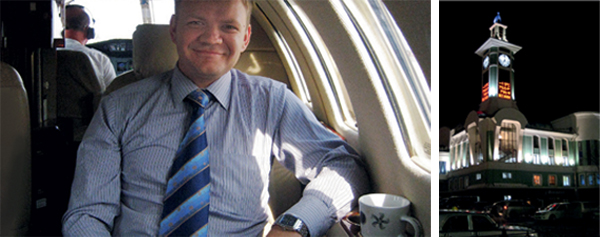Denis Stepanov sometimes travels 10,000 kilometres on a business trip. He is responsible for ebm-papst’s sales in Siberia
Siberia — the word brings to mind huge distances, few people and, above all, bitter cold. And this description is entirely accurate. The snow cover around the Siberian ebm-papst office in Yekaterinburg is rather deep as early as late November. However, Stepanov does not let this get in the way of his business trips. As the only outside salesperson in Siberia, he has to cover an enormous sales territory — more specifically, ebm-papst’s largest in the entire world — by himself. “Of course, my everyday work also includes regular office tasks,” Stepanov relates. “However, I spend about half of my working time on the road.” In Siberia, customer contact is key. From his sales office, Stepanov travels to customer events, product presentations and, above all, negotiations.

Stepanov travels as far as Chabarowsk at the Chinese border — 5,000 kilometers away from his office
To cover all of the customers,
good planning is everything. Most of all, this means keeping a close eye on the weather report. One has to be ready for anything: Siberia’s climate ranges from a sweaty 35 degrees Celsius in summer to an unbelievable minus 70 degrees Celsius during the cold season. This extreme range is also encountered within any given season. Siberia includes multiple climate zones, which Stepanov can often feel right on his skin: “At the same time of year, I can wear just a T-shirt here at home, while I have to break out a heavy coat in other locations.”
A different kind of frost protection
Given the often cold surroundings, it sounds almost paradoxical that Stepanov cites ground cooling as one of the most important projects. “That plays a great role here,” he says. “After all, oil production is one of the most important sectors of the Siberian economy.” We can quickly understand what that means by looking at the conveyor systems on the northeastern peninsula of Taimyr: in winter, the frozen soil thaws quickly, as the crude oil heats up to temperatures as high as 50 degrees Celsius when pumped out of the ground. If the plant falls into the sump thus created, the results are catastrophic. Exactly that is prevented by cooling machines with centrifugal fans in GreenTech EC technology, which keep the ground at a constant temperature around the freezing point, regardless of the weather.

On his business trips, Stepanov often has go by plane (left). In Novosibirsk degrees around minus 19 celsius are quite normal (right)
Projects such as these require Stepanov to drive thousands of kilometres, as Siberia is one of the world’s least densely populated regions, with an average of only three people per square kilometre. Accordingly, there are only a few major urban areas, with a lot of nothing in between. Novosibirsk, for example, is about 1,500 kilometres from Yekaterinburg, while Vladivostok is even 5,000 kilometres — it would take several days to make the drive by car. These distances do not bother Stepanov much: “I can fly to any region in just a few hours,” he explains.
“To keep the business trips at least somewhat manageable, I purposely chose Yekaterinburg as the headquarters.” Russia’s fourth largest city, which will be one of the venues for football’s World Cup in 2018, is located in southern Siberia, a major centre of Russian industry. Only the means of transport have not quite kept up with this status. Usually, Stepanov has to make short trips by bus or taxi, which often get caught in Russia’s infamous traffic jams. The only Siberian city with an underground system is Novosibirsk, where two Metro lines run. However, improvement is in sight, and Stepanov relates proudly how he took on a project for another city’s streetcar system.
Keeping out draughts
“The streetcar company of the city of Irkutsk approached me back then with a problem,” reports Stepanov. The passengers had to cope with average outside temperatures as low as –45 degrees Celsius. At every stop, the open doors caused a draught to blast through the wagons, sending a chill through the whole compartment in seconds. Even at full power, the heating system was not powerful enough to heat the air by the next stop. The solution: The company took Stepanov’s advice and installed a warm air curtain at each door. This keeps the cold outside. The warm air curtains are activated only when the doors are actually open. This ensures energy efficiency. Since the installation, feedback from passengers has been entirely positive. Finally, they can take off their hat and gloves in the city train. This also impressed the streetcar manufacturers, who have since made the warm air curtains standard in Siberian cities.
When Stepanov talks about this project, it is easy to tell how much fun he has in his work: “Basically, I am doing the same thing as my many colleagues around the world. Customers come to me with a problem, and we then solve it together.” Despite the massive distances in Siberia, he has a job that allows him to deal with many interesting people. “That is a very nice fringe benefit,” he adds.


Leave a comment